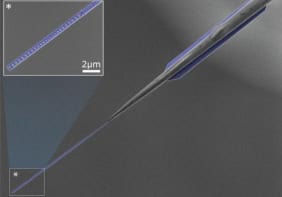Robocops could soon leave the realm of science fiction thanks to a new bullet-proof material proposed by engineers in Australia. According to computer simulations done by the team, bullets would be no match for vests made of the material, and would simply bounce off owing to the high elasticity of the nanotubes. The researchers claim that the material, which has not been made yet, would be a great improvement on existing anti-ballistic clothing that stop bullets from penetrating by spreading the bullet's force -- something that can still cause serious injury (Nanotechnology 18 475701 ).

Carbon nanotubes are strong, lightweight and thanks to their high elasticity are able to absorb huge amounts of kinetic energy. By modelling the impact behaviour of these nanomaterials, Kausala Mylvaganam and Liangchi Zhang of the University of Sydney have shown that nanotubes can withstand fast moving bullets by rebounding their force. The simulations also suggest that nanotubes are resistant to damage by repeated ballistic impacts, which is crucial if they are to be used in body armour.
The Australia engineers obtained their results by modelling the behaviour of single-walled carbon nanotubes fixed at both ends that were impacted with tiny “bullets” made of diamond. The bullets had speeds of between 1000 and 3500 m/s and were fired perpendicular to the nanotube axis. The researchers investigated the relationship between the nanotube’s radius, the position where the bullet strikes, its speed and the energy absorbed by the nanotube.
Mylvaganam and Zhang found that the nanotubes were resistant to bullet speeds of over 2000 m/s, even after multiple impacts. (For comparison, the speed of rifle bullets can reach 1500 m/s and most gun bullets have speeds of less than 1000 m/s). The centre of a nanotube appeared to be the most resilient.
The duo says that bullet-proof vests could be made by using “nanotube yarn”. Here, the carbon nanotubes would be spun into fibres, probably using a technique called electrospinning. The researchers have calculated that body armour just 600 microns thick made from six layers of 100 micron yarns could bounce off a bullet with a muzzle energy of 320 Joules – which is typical of a light firearm.
Such vests would be better than existing anti-ballistic clothing, which is usually made of multiple layers of Kevlar, Twaron and Dyneema fibres. Although they stop bullets from penetrating, they do this by dissipating force over an area larger than the bullet, which can still cause injuries known as blunt force trauma. These range from severe bruising to critical organ damage. The high level of elastic storage energy of carbon nanotubes means that such trauma could be avoided.
Although this research is theoretical, previous work by many groups around the world has shown that nanotubes can be effectively spun into yarns. So the next step would be for someone to actually make a prototype vest.



